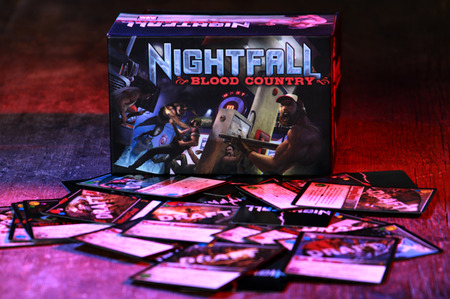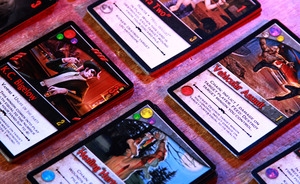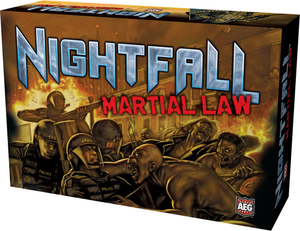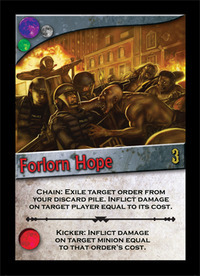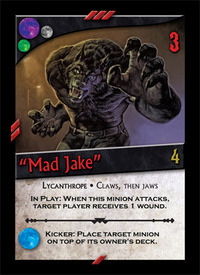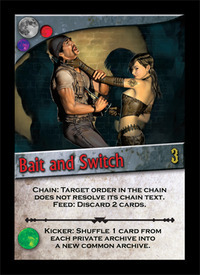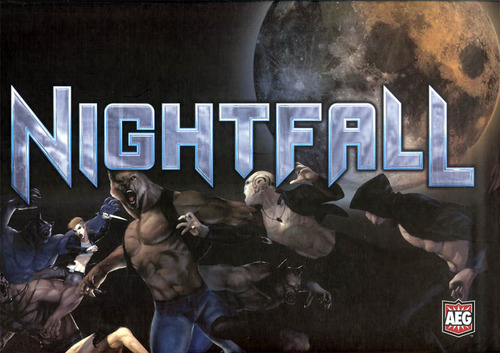Nightfall: The Coldest War - Staking New Territory
 Monday, August 6, 2012 at 11:30AM
Monday, August 6, 2012 at 11:30AM 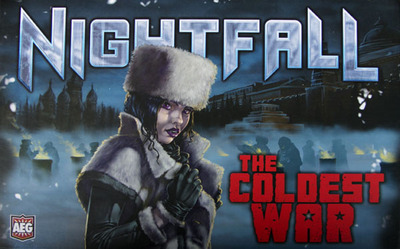
I've been playing Nightfall since it first came out, and have been impressed with the low-downtime cutthroat fun delivered through it's unique chaning mechanic. In my review of the last expansion in the series, Blood Country, I had expressed some concern that the Tru-blood style settings and themes in the various Nightfall entries were becoming somewhat similar. Almost as if AEG has read my mind, I find the newest expansion The Coldest War half a world away from the humid nights of the American South, revealing instead how Nightfall has affected the cradle of vampire myth: the fridgid tundra of mother Russia.
Nightfall: The Coldest War not only opens up a refreshingly new thematic setting, it also introduces the widest variety of changes to core gameplay so far in the series. With new starting minions, moon phase cards that change the overall playfield, a couple of new mechanics that turn the game on it's head, and a set of fully illustrated wound cards, there is a ton of new content packed in the box.
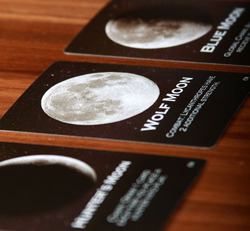 Like Nightfall: Martial Law, The Coldest War can be played as a standalone game. However, where Martial Law duplicated some cards from the base set, The Coldest War presents an entirely new cast of starting characters, as well as gives all of the wound cards a graphical facelift. If one word can describe The Coldest War, it is "change".
Like Nightfall: Martial Law, The Coldest War can be played as a standalone game. However, where Martial Law duplicated some cards from the base set, The Coldest War presents an entirely new cast of starting characters, as well as gives all of the wound cards a graphical facelift. If one word can describe The Coldest War, it is "change".
Has this new Nightfall toppled a Berlin Wall-like barrier holding back it's thematic potential, or has it dropped like an Iron Curtain separating the new play experience from it's core audience? Let's take a look at the new changes in a bit more detail, and I'll give you my impressions.
Setting:
The biggest change to the game is the new setting. In what seems like a complete reversal of the Tru-Blood style Americana slasher, Nightfall: The Coldest War opens up an entirely new continent with plenty of supernatural lore to explore. As children, practically every one I have known has played make-believe as the stereotypical movie vampire while laying on a thick slavic accent. The minions in The Coldest War may be foreign, but their horror heritage will allow any players to comfortably assimilate the thematic flavor that theiy bring to the game. That's not to say that Nightfall has done a 180, and is delivering 1800's dracula; Not at all, it's still the same mix of urban decay Nightfall does so well - but the minions and artwork in this expansion have a bit more foreign charm than the previous settings.
I really like this detour in setting. I was getting a bit bored with the sameness of the theme 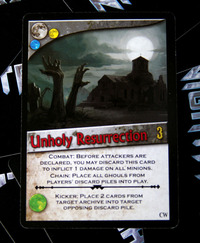 in the previous expansions, and I was pleasantly surprised at how refreshing a simple change of locale made to he gameplay experience. I hope that AEG continues along this line and explores all of the shadowy nooks and crannies of the newly decaying world.
in the previous expansions, and I was pleasantly surprised at how refreshing a simple change of locale made to he gameplay experience. I hope that AEG continues along this line and explores all of the shadowy nooks and crannies of the newly decaying world.
Mechanics:
Moon Phase - One of the biggest changes introduced by The Coldest War is the inclusion of Moon Phase cards. An optional addition, moon phases are represented by a small deck of cards, each card depicting a certain phase of the moon. Each moon phase adds a global effect to the game, usually helping or hindering a particular type of minion (Lycanthrope, Vampire, Ghoul, etc..). Players can choose to manipulate these cards on their turn by blindly drawing the next one from the deck or shuffling the deck.
This gives an interesting flavor to the game, and although there is a bit of allowance for strategy when deciding when to draw vs. shuffle, it is still pretty random. It definitely spices up the game, though, and actually gives some purpose to the different minion types. Players may be divided about whether or not they like this particular mechanism, but it's optional status means that it can easily be left out if it is not your cup of tea.
Combat Effects - While the moon phase cards may seem like a big change to the game, the biggest change is actually much more subtle. Many cards in The Coldest War contain combat effects: actions that can be taken during combat by playing the card directly from the player's hand without chaining. This will probably be the most controversial aspect of this expansion. The chaining mechanic is really the core of Nightfall, but these new combat effects essentially bypass it. These effects may be likened most to "instants" in Magic the Gathering, allowing players a chance to save themselves or damage others out of turn. We have seen this mechanic 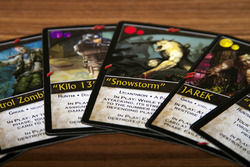 before in some of the wound cards introduced in previous sets, but The Coldest War really brings the concept into the spotlight.
before in some of the wound cards introduced in previous sets, but The Coldest War really brings the concept into the spotlight.
Personally, I like the addition. One of the apparent shortcomings of Nightfall after many plays is that it can be prone to "Kingmaking", where all of the players beat up on another - virtually forcing him out of the game. The ability to more nimbly counter these attacks takes some strides to level the playing field. Players may feel that these cards are a bit more powerful than the standard cards due to the fact that they have potent effects without having to consider their colors, but I felt that they brought an interesting, refreshing twist to the formula.
New Wound Cards - The Coldest War not only introduces new wound cards with a flexible effect that acts as a wildcard to chain any two colors together, it also includes cards from the previous games with slick new art that is much nicer than the simple bullethole graphic found in the original. Since each of the older expansions have unique wound effects, this is actually like getting bonus cards in the coldest war expansion. (Even if you are like me and snag each new expansion as it comes out, the new art is worthwhile in and of itself.)
New Starting Decks - While every full expansion up until The Coldest War has included a set of starting characters, they have been the same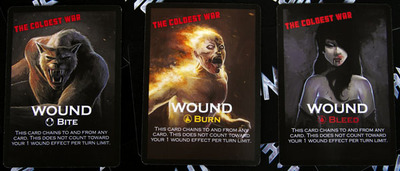 familiar faces in each set. With the setting change in The Coldest War comes a new cast of starting characters as well, which is a breath of fresh air. I'm not sure that these new characters were built with beginners in mind though, as their effects and powers are a bit more nuanced than the basic set, with one or two that may seem downright weaker at first glance. As a set though, these new starting characters are balanced and play differently enough to be worth exploration. I am already starting to notice changes in my strategies while utilizing these new starting cards.
familiar faces in each set. With the setting change in The Coldest War comes a new cast of starting characters as well, which is a breath of fresh air. I'm not sure that these new characters were built with beginners in mind though, as their effects and powers are a bit more nuanced than the basic set, with one or two that may seem downright weaker at first glance. As a set though, these new starting characters are balanced and play differently enough to be worth exploration. I am already starting to notice changes in my strategies while utilizing these new starting cards.
Conclusion:
The Coldest War definitely has a new feel to it, and plays much differently than the previous games. The combat effects really change things up and create a faster, more aggressive, and immediate game. I can't help but feel that Coldest War brings a bit more "Magic the Gathering" flavor to Nightfall, by adding more complicated interactions that require a new type of thinking about how, and where cards can be utilized.
While this new mechanism seems to address kingmaking a bit, it also makes the game much more cutthroat, 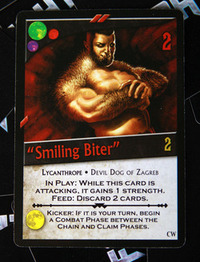 and changes its nature significantly. If you want more of a CCG feel in your Nightfall, then this will be an excellent addition, but those who feel that Nightfall is already too chaotic may want to steer clear. I enjoy the new mechanics, and feel that they help revive a game that was starting to falter with expansions that were beginning to feel too similar.
and changes its nature significantly. If you want more of a CCG feel in your Nightfall, then this will be an excellent addition, but those who feel that Nightfall is already too chaotic may want to steer clear. I enjoy the new mechanics, and feel that they help revive a game that was starting to falter with expansions that were beginning to feel too similar.
Some players may feel that the optional Moon Phase cards add a bit too much randomness to the game as well, but I really enjoy that the moon phases give more purpose to the different creature types found in the decks, delivering an added dimension of strategy to the card draft process. I may not use Moon Phases in every game I play, but the ability to add them on a whim is a welcome inclusion.
I think that Nightfall was really due for a refreshing change, and The Coldest War really delivers. There is enough newness here to last for quite a while. That being said, The Coldest War may not work very well as an introduction to Nighfall - the new mechanics all bend the basic core of the gameplay, and while exciting for the veteran player, this may seem aimless and without focus to the beginner. If you are looking to dip your toes into the Nightfall universe for the first time, the base game is still the best entrypoint.
All in all, Nightfall: The Coldest War is a solid entry for the veteran Nightfall player and should scratch the itch for those who are looking for something to spice up their gameplay - just be aware that this changes the nature of Nightfall quite a bit, and may require a paradigm shift in strategies that are used to succeed.
 AEG,
AEG,  David Gregg,
David Gregg,  Nightfall,
Nightfall,  alderac,
alderac,  card game,
card game,  review,
review,  the coldest war in
the coldest war in  Board Games
Board Games 
